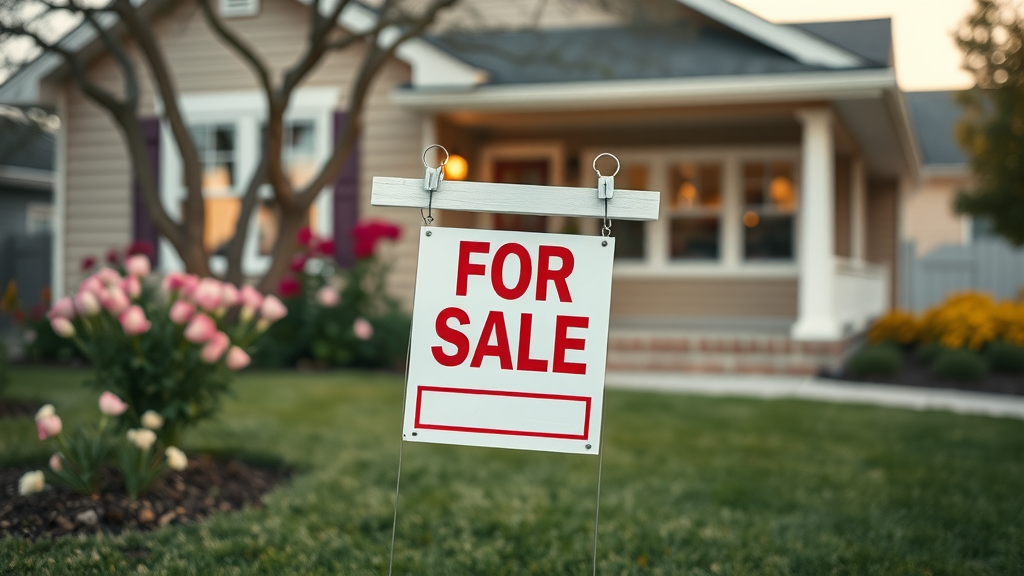Selling your home can feel like an uphill battle, especially in a slow market. If you’re grappling with the question, “ How do I sell my house in a slow market? ” you’re not alone. Many homeowners find themselves in similar situations, but fear not—there’s hope! By mastering proven strategies tailored for these challenging times, you can turn the odds in your favor. This article will guide you through essential tips and techniques that not only enhance your selling power but also ease the stress of the process. Let’s unlock your home’s potential together!
Understanding the Slow Market Dynamics
What Does Selling in a Weak Market Mean?
In property, a weak market typically refers to a period when homes are taking longer to sell, and buyers are less aggressive. This can be due to various factors, including economic downturns, rising interest rates, or an oversupply of homes. Understanding these dynamics is crucial when deciding to sell your house in a slow market.
Key Characteristics of a Slow Market:
- Longer Time on Market: Homes may sit unsold for extended periods.
- Lower Demand: Fewer buyers actively looking to purchase.
- Price Reductions: Sellers may need to lower prices to attract buyers.
In a declining market, it’s essential to adapt your selling strategies to stand out among competing listings.
Factor |
Impact on Selling |
|---|---|
Economic Conditions |
Lower demand |
Interest Rates |
Can deter buyers |
Supply of Homes |
Oversaturation leads to more competition |
Current Market Conditions and Trends
The current market conditions significantly influence how you approach selling your home quickly. Experts suggest keeping a close eye on trends such as average house prices , buyer preferences, and local economic conditions. The UK Property Market Report provides valuable insights into these trends.
Current Trends to Watch:
1. Interest Rates: Higher rates can decrease buyer purchasing power.
2. Buyer Preferences: A shift toward more energy-efficient homes.
3. Remote Work: Increased demand in suburban and rural areas.
“Understanding the nuances of the current market can significantly impact your selling strategy.”

Setting the Right Price to Sell My House in a Slow Market
How to Analyze House Prices and Market Value
Setting the right price is crucial when you aim to sell your house fast in a slow market. Conducting a thorough analysis of comparable homes, also known as comps , can help you establish a competitive price.
Steps to Analyze Market Value:
1. Research Recent Sales: Check sales data for similar homes in your area.
2. Consider Market Conditions: Analyze how current conditions affect pricing.
3. Consult Professionals: Engage with a local estate agent for expert advice.
The Importance of Competitive Pricing
Competitive pricing can attract potential buyers, even in a slow market. If your home is priced too high, it may deter buyers, causing your property to linger on the market.
Strategies for Competitive Pricing:
- Price Below Market Value: Consider pricing slightly lower than recent comps to attract interest.
- Allow Room for Negotiation: Set a price that offers flexibility for negotiation.
- Regularly Review and Adjust: Stay informed about changing market conditions and adjust your pricing strategy accordingly.
Pricing Strategy |
Advantages |
Disadvantages |
|---|---|---|
Below Market Price |
Attracts more buyers |
Potential lower profits |
Competitive Pricing |
Balances interest & value |
Requires market knowledge |
High Price with Flexibility |
Allows for negotiation |
May lead to extended market time |
“Being adaptable with your pricing strategy can significantly enhance your chances of a quick sale.”

Enhancing Your Property’s Appeal
Kerb Appeal: First Impressions Matter
When you aim to sell your house in a slow market, enhancing your kerb appeal is a must. The exterior of your home is the first thing buyers will see, so making a great impression is crucial.
Tips for Improving Kerb Appeal:
- Maintain the Lawn: Regular mowing and edging create a tidy appearance.
- Fresh Paint: A new coat of paint on the front door can be inviting.
- Clean Up: Remove clutter and ensure the entrance is welcoming.
Effective Home Staging Tips
Staging your home can help potential buyers visualize themselves living there, making it essential in a slow market. A well-staged home can sell faster and at a better price.
Home Staging Strategies:
1. Declutter: Remove personal items and excess furniture.
2. Neutral Colors: Use neutral tones to appeal to a wider audience.
3. Highlight Unique Features: Emphasize the strengths of your home.
Staging Element |
Impact on Buyers |
|---|---|
Cleanliness |
Creates a positive impression |
Neutral Decor |
Appeals to more buyers |
Highlighted Features |
Makes the home memorable |

Marketing Strategies for a Successful Sale
Utilizing Online Platforms and Social Media
In today’s digital age, leveraging online platforms and social media can significantly enhance your visibility when trying to sell your house in a slow market.
Effective Online Marketing Tips:
1. Create Engaging Listings: Use high-quality photos and compelling descriptions.
2. Utilize Social Media: Share your listings on platforms like Facebook and Instagram.
3. Engage with Local Communities: Join local online groups to promote your property.
The Role of Professional Photography and Virtual Viewings
High-quality visuals and virtual tours can make a significant difference in attracting buyers. Investing in professional photography can highlight your home’s best features.
Benefits of Professional Marketing:
- Increased Interest: Quality images garner more attention.
- Convenience: Virtual viewings allow potential buyers to explore from home.
- Competitive Edge: Stand out among listings with professional-grade content.
Marketing Strategy |
Advantages |
Considerations |
|---|---|---|
Professional Photography |
Enhances visual appeal |
May require upfront costs |
Virtual Viewings |
Convenience for buyers |
May not replace in-person visits |
Social Media Marketing |
Wider audience reach |
Requires ongoing engagement |

Navigating the Sales Process Effectively
Choosing the Right Estate Agent
Selecting the right estate agent is vital in a weak market. An experienced agent can guide you through the selling process and help you navigate challenges.
Factors to Consider:
1. Local Knowledge: They should have a deep understanding of the local market.
2. Track Record: Review their previous sales successes.
3. Communication: A good agent should be responsive and communicative.
Understanding Agent Fees and Commissions
It’s essential to understand the agent fees and commissions involved in selling your home. This understanding can help you budget effectively and avoid surprises.
Common Agent Fees:
- Commission Rates: Typically range from 1% to 3% of the sale price.
- Marketing Costs: Some agents may charge additional fees for marketing services.
- Legal Fees: Ensure to account for legal costs as well.
Fee Type |
Typical Range |
|---|---|
Commission |
1% - 3% of sale price |
Marketing Costs |
Varies (often additional) |
Legal Fees |
£500 - £1,500 |

Making a Cash Offer: Benefits and Drawbacks
Understanding the Cash Home Buyer Advantage
Selling to a cash buyer can be an attractive option in a slow market. Cash offers often lead to quicker transactions, as they eliminate many common hurdles associated with financing.
Advantages of Selling to Cash Buyers:
- Faster Transactions: No mortgage processing delays.
- Less Risk: Cash buyers eliminate the risk of financing falling through.
- Fewer Contingencies: Cash deals typically have fewer conditions.
Cash Offer Considerations
While cash offers have advantages, they also come with considerations. It’s essential to weigh the pros and cons before deciding.
Potential Drawbacks:
- Lower Offers: Cash buyers may offer less than the market value.
- Limited Buyer Pool: Not all buyers can afford cash purchases.
- Appraisal Issues: Cash buyers may not require appraisals, which can affect pricing.
Cash Offer Advantage |
Cash Offer Drawback |
|---|---|
Quick sale |
Potentially lower offers |
Reduced risk |
Limited buyer pool |

Common Reasons for Selling in a Slow Market
Personal and Financial Motivations
There are various personal and financial motivations for selling in a slow market. Understanding these motivations can help you better position your home for potential buyers.
Common Motivations:
1. Relocation: Job transfers or family reasons.
2. Financial Needs: Need to access equity or downsize.
3. Market Positioning: Awareness of changing market conditions.
Market Conditions Affecting Home Sales
Market conditions can significantly affect your decision to sell. Staying informed about local and national trends can guide your timing and strategy.
Key Market Conditions:
- Interest Rate Fluctuations: Higher rates can decrease buyer interest.
- Economic Outlook: Economic uncertainties can lead to reduced buyer confidence.
- Local Market Activity: Keep an eye on local inventory levels.

Avoiding Pitfalls When Selling My House in a Slow Market
Recognizing Red Flags in the Selling Process
When trying to sell your house in a slow market, it’s vital to recognize red flags that may indicate potential issues in the selling process.
Common Red Flags:
- Lack of Interest: No inquiries or viewings after listing.
- Lowball Offers: Frequent low offers can indicate pricing issues.
- Agent Communication Issues: Poor communication from your agent.
How to Handle Low Offers
Receiving low offers can be discouraging, but it’s essential to approach this situation strategically.
Strategies for Handling Low Offers:
1. Stay Calm: Don’t take it personally; it’s part of the process.
2. Counter Offer: Consider countering with a more reasonable price.
3. Evaluate Buyer Motivation: Understanding their situation can help you decide.
“Navigating the selling process requires vigilance and adaptability to avoid common pitfalls.”

Key Takeaways for Selling My House in a Slow Market
Summary of Essential Strategies
Selling your house in a slow market requires a mix of strategic pricing, effective marketing, and keen awareness of market dynamics . Here are the key points to remember:
- Price Competitively: Research and analyze your local market.
- Enhance Appeal: Focus on kerb appeal and staging.
- Leverage Technology: Utilize online platforms and professional photography.
Final Thoughts and Recommendations
In a declining market, being informed and flexible can make all the difference in successfully selling your home. Keep abreast of market trends, engage with professionals, and maintain a positive outlook.

Additional Resources
Related Articles and Guides
For further guidance on navigating the real estate landscape, consider exploring the following resources:
- Dealing with Estate Agents
- How Long It Takes to Sell a Property
Further Reading for Home Sellers
Frequently Asked Questions
How long does it typically take to sell a house in a slow market?
- On average, houses can take longer to sell in a weak market, often exceeding the typical 3-6 month timeframe.What are the key factors that influence house prices?
- Factors include location, condition of the property, market demand, and economic conditions.Is it worth investing in home staging?
- Yes, home staging can significantly enhance buyer interest and lead to quicker sales.
Conclusion
In conclusion, selling your home in a slow market presents unique challenges but is achievable with the right strategies. From setting a competitive price to effectively marketing your property, every step counts.
Call to Action: Call us at 07713 057 427 for Your FREE Valuation!
Key Takeaways:
- Understand market dynamics and pricing strategies.
- Enhance your home’s appeal through staging and kerb appeal.
- Utilize online marketing and professional photography.
- Be vigilant in recognizing potential pitfalls during the selling process.
 Add Row
Add Row  Add
Add 





 Add Row
Add Row  Add
Add 








Write A Comment